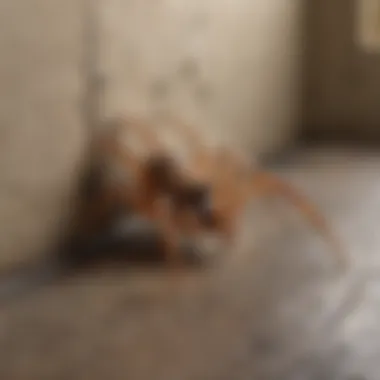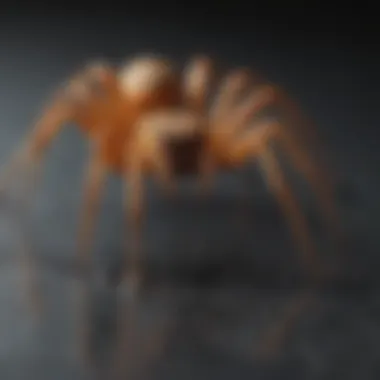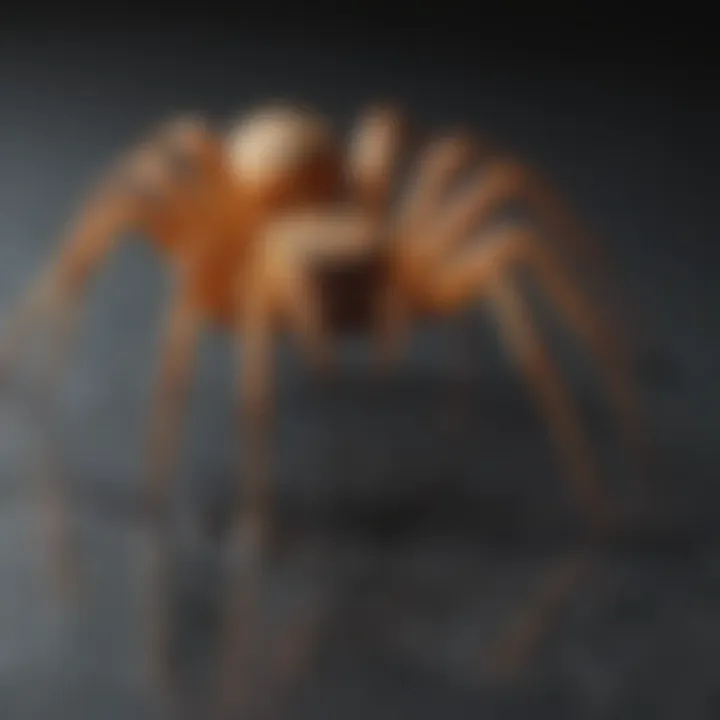Effective Strategies to Keep Spiders Out of Your Home


Intro
Spiders are often labeled as unwelcome guests in homes, lurking in corners and crevices. While many might perceive them as mere nuisances, understanding their role in the ecosystem can help homeowners appreciate their presence, if not fully embrace it. Yet, there’s a fine line between coexistence and invasion. This article offers practical guidance on keeping spiders out of your living space while also outlining the steps to take should they decide to squat in your home.
From identifying common species to understanding their habits, we aim to equip you with the knowledge and tools necessary to maintain a spider-free environment. Let’s dive into the world of spiders, unraveling their secrets and discovering effective strategies to manage their presence effectively.
Understanding Spiders
Understanding spiders is not just a matter of helping you to keep them out of your house; it's about recognizing their role in our ecosystem and knowing how they behave. Spiders, though often seen as unwelcome guests, can be quite informative in terms of their biological habits and preferences. This knowledge ultimately aids in devising effective strategies for keeping them at bay, while also respecting their contributions to our environment.
The Common Types of House Spiders
Identification Characteristics
Identifying the common types of house spiders can significantly help in understanding which species you're dealing with. Most people cannot tell a black widow from a common house spider, yet familiarizing oneself with these traits can prove beneficial. For example, the common house spider has a grayish or tan coloration with a characteristic small abdomen, whereas a black widow is easily recognized by its glossy body and distinctive hourglass marking. Understanding these key features aids not only in identification but also in assessing the urgency of dealing with the spider. A basic but unique aspect is their webs: those of common house spiders are often messy and irregular, while others like the orb-weaver create more symmetrical and structured webs.
Habitat Preferences
House spiders have specific habitat preferences that can determine their presence in your home. Many prefer dark, damp areas such as basements, attics, and corners where light does not reach. Recognizing where these spiders thrive allows homeowners to take preventive measures in these locations. For instance, making sure to keep utility rooms tidy and clutter-free decreases the likelihood of spiders finding a suitable habitat. The unique feature of understanding these preferences is that it enables you to target specific areas for cleaning and sealing, greatly reducing the chances of unwanted visitors.
Foraging Behavior
Foraging behavior is another critical aspect to consider. Spiders are generally opportunistic predators, feeding on insects that venture into their webs or nearby areas. Understanding their foraging habits helps homeowners realize that reducing the overall insect population may, in turn, minimize spider encounters. Another key characteristic is how some spiders are more active at night, which might lead to a surprise sighting if you're not careful. Their hunting techniques highlight a unique feature: as they are primarily beneficial by controlling insect populations, a delicate balance is at play - less insects might mean fewer spiders, but also fewer natural pest controllers in your home.
The Ecological Role of Spiders
Natural Pest Control
Spiders act as natural pest control agents, preying on various insects that could otherwise invade your space. It's often overlooked but these creatures contribute significantly to maintaining an ecological balance. For instance, garden spiders are incredibly effective at targeting mosquitoes and flies, which are often more bothersome. Their presence is a clear sign of a natural ecosystem; however, they can cause discomfort when they enter living spaces unexpectedly. Understanding their role here helps homeowners appreciate their function while devising strategies to keep them outdoors.
Ecological Balance
Ecological balance is crucial for maintaining a healthy living environment. Spiders play an indispensable role in this balance by preying on pests that might otherwise overpopulate. For instance, a sudden decline in spider populations may lead to a surge in insect populations, which could result in more significant issues in terms of infestations. Recognizing this dynamic can help make more informed choices regarding pest control methods. Spiders can seem daunting, but their existence is intertwined with the health of our homes and gardens.
Misconceptions About Spiders
There are numerous misconceptions surrounding spiders. Many individuals might believe that all spiders are harmful, which is far from the truth. A majority are harmless and beneficial to the environment. A prime example is the garden spider, often seen as a nuisance but is quite harmless and helps in controlling insect populations. These misconceptions can lead to unnecessary panic and inappropriate measures. Understanding the unique role and benefits of spiders helps dismiss fears and recognize their importance, ultimately guiding homeowners towards more effective management techniques without resorting to harmful practices.
Common Entry Points for Spiders
Understanding how spiders gain access to our living spaces is pivotal in devising effective preventive measures. Identifying the common entry points not only helps us to take action but also augments the overall strategy for maintaining a spider-free home. For instance, sealing gaps and addressing nearby foliage can reduce the chances of an invasion dramatically.
Cracks and Gaps
Foundation Cracks
Foundation cracks can be a spider’s best friend. These tiny fissures can serve as gateways for all sorts of critters. If your home has a foundation issue, it's likely that it also opens up opportunities for spiders to move in. The key characteristic of foundation cracks is their often unnoticed growth over time, which can extend the spider population right into your living room, unbeknownst to you.
One significant advantage of addressing these cracks is that fixing them goes beyond just spider control. It often involves enhancing the structural integrity of your home. However, the disadvantage here is that repairs can be costly and may require professional help—an inconvenient truth for many homeowners.
Window and Door Frames
These frames can harbor gaps that might appear insignificant but are enough for spiders to squeeze through. The key aspect here is that these openings are typically overlooked during home maintenance checks. Regularly inspecting and tightening these areas aids in diminishing spider ingress significantly. The appeal lies in the simplicity of the solution; just ensure these frames are sealed well, which can save anxiety in the long run. Yet, neglecting this part of your house can lead to more than just spider visits; it could invite other pests as well.


Utility Line Entrances
Every utility line that enters your home can be an entry point. Whether it's electrical wires or plumbing, these interfaces can have gaps where spiders are prone to wiggle on in. The unique feature of utility line entrances is that not all homeowners consider these potential hazards. By caulking the spaces where the lines enter, the risk can be mitigated.
However, one must note that over-sealing could also lead to issues such as moisture build-up or overheating appliances, so a balance must be struck.
Overgrown Vegetation
Proximity to the House
Spiders love to create webs close to areas where they can easily hunt. If there’s overgrown grass or bushes very close to your house, it can become an ideal hunting ground for them, making it easier to cut through to your home. The key characteristic here is that keeping vegetation trimmed not only beautifies your landscape but significantly decreases spider activity. The advantage of such maintenance is twofold: reducing spider presence and upping the curb appeal of your property. But beware, there’s a time commitment involved in regular upkeep, which can be a downside for busy homeowners.
Unmanaged Landscaping
Landscaping gone haywire can also invite unwanted guests. Dense bushes and tall plants can serve as a welcoming sign for spiders that are on the prowl for shelter and food. The benefit of effective landscaping means not letting your household become a spider vacation spot. However, neglecting these details can result in a mini-ecosystem thriving too close for comfort. This might require greater effort in terms of managing your garden space and watching out for growth throughout the seasons.
Seasonal Growth Patterns
During different times of the year, certain plants grow faster and provide more cover. In the spring, for instance, plants flush out new leaves and heighten the chances of spiders finding a cozy home near your abode. The key point here is understanding these seasonal patterns allows for preventative maintenance where you can adjust your foliage accordingly.
Yet, not everyone has a green thumb or the time to constantly monitor growth. Awareness here plays a vital role in mitigating access to spiders.
Openings Around Pipes and Vents
Kitchen and Bathroom Plumbing
Water lines often open up potential gaps. Spiders can easily lose their way and end up in your kitchen or bathroom through these openings. The key characteristic of these areas is that they offer moisture, which is attractive to spiders. Sealing these points effectively can reduce the chances of unwelcome visitors.
But there’s a disadvantage; some solutions might involve professionals to ensure that plumbing remains functional while still achieving the spider-proofing goal.
Exhaust Fans
Exhaust fans serve a vital function in homes but can also be a potential entry point if not properly maintained. A small gap around the fan could lure spiders inside. It's beneficial to regularly check these areas and ensure that screens or covers are in place to thwart spider access. However, neglect in this area can result in buildup that not only invites spiders but could also be detrimental to overall air quality.
Attic and Basement Vents
Vents are necessary but can provide direct access points for spiders seeking shelter. The unique feature of these openings is that they facilitate airflow but can simultaneously allow spiders an entryway into your home. Ensuring that these are covered with fine mesh screens can be an effective measure.
However, remember that blocking these vents completely could lead to ventilation issues. Regular checks can help find the right balance, allowing for airflow while keeping spiders at bay.
Key Takeaway: Being proactive about identifying and sealing potential entry points significantly reduces the chances of a spider invasion in your home. Regular maintenance checks can make your home less inviting to these unwanted guests.
Preventive Measures for Spider Control
When it comes to keeping your home spider-free, preventive measures play a pivotal role. These strategies not only reduce the likelihood of a spider invasion but also create a more comfortable living environment. By being proactive, you can establish a barrier that deters spiders from feeling at home in your cozy nook.
Sealing Entry Points
Acrylic Caulk
Acrylic caulk stands out as a top pick for sealing small openings and cracks where spiders might sneak into the house. Its flexibility allows for easy application and adhesion to various surfaces, ensuring even the tiniest gap gets filled. Unlike some alternatives, it dries clear, making it a neat choice for interior spaces. One unique feature is that it can be painted over, allowing homeowners to blend it seamlessly into their surroundings. However, acrylic caulk isn’t always the best option for areas exposed to excessive moisture, as it may break down over time.
Expandable Foam Sealants


Expandable foam sealants offer robust protection against unwanted pests. This product expands upon application, filling holes and cracks effectively. The key characteristic that makes it a popular choice is its ability to form a solid barrier. It's also resistant to water, making it ideal for outdoor applications or damp areas. While its insulating properties are beneficial, some users find that the foam can be a bit of a hassle to trim back once it dries, and it may require some finesse during application to avoid unwanted mess.
Weather Stripping
Adding weather stripping is another powerful way to keep spiders at bay. Often used for doors and windows, this material plays a crucial role in creating a tight seal against the outside world. It’s especially helpful in preventing drafts, which can lure critters inside. The advantage of weather stripping is its variety of styles. You can choose from adhesive strips, metal sweeps, or foam options to suit your needs. Just be mindful that it may need periodic replacement, as wear and tear can lessen its effectiveness over time.
Maintaining a Clean Environment
Regular Cleaning Routines
Keeping a tidy home by establishing regular cleaning routines is fundamental in spider control. Dust and clutter provide the perfect hiding spots for these little creatures, making your house their cozy retreat. The key to successful cleaning is consistency. Setting aside time each week for dusting and vacuuming can minimize potential nesting areas for spiders. Vacuuming, in particular, is critical, as it not only removes webs and spiders but also the eggs they might have laid. However, if you don't stay on top of it, those cleaning routines can become a daunting task.
Decluttering Rooms
Decluttering is like a breath of fresh air for your home. When space is clear and organized, you effectively remove potential spider habitats. It’s easier to monitor for any unwelcome guests when everything has a designated place. Simple actions like storing items in bins and regularly assessing your belongings help keep the chaos at bay. One unique feature of decluttering is how it can positively impact mental clarity, alongside spider prevention. On the downside, it requires dedication; simply shoving things into closets won't address the underlying issue of over-accumulation.
Vacuuming Techniques
Employing effective vacuuming techniques can enhance your spider prevention strategy significantly. Using a vacuum with a long hose attachment can help reach those pesky corners and crevices where spiders love to hide. Opting for a vacuum with good suction ensures you catch not just the spiders, but also their webs and eggs. It's beneficial to regularly change the vacuum bag or empty the canister to ensure that any trapped spiders don’t invite their friends along. Remember though, you need to commit to regular use; otherwise, the effectiveness will diminish as dust settles back into the spaces.
Utilizing Natural Deterrents
Essential Oils and Their Efficacy
Integrating essential oils into your spider prevention strategies can be both pleasant and effective. Scents like peppermint and tea tree oil are particularly effective at keeping spiders at bay; they dislike these strong aromas. A simple mix of water and a few drops of essential oil can be sprayed around windows and entry points. The unique feature of essential oils is that they provide a safe and pleasant alternative to harsh chemicals. However, their strong scent fades over time, so you'll need to reapply periodically to maintain their spider-repelling properties.
Vinegar Solutions
Vinegar, a common household staple, doubles as a natural deterrent for spiders. Mixing equal parts of vinegar and water creates an effective spray that can disrupt spider habitats. The acidic nature of vinegar is uncomfortable for spiders, helping to deter them. One advantage is that it doesn’t pose harm to most plants, allowing you to use it freely indoors and outdoors. However, while vinegar is useful for repelling spiders, it can sometimes alter your home’s smell temporarily, which might be off-putting if used excessively.
Plant-Based Repellents
Exploring plant-based repellents like citrus peels and mint can contribute to keeping spiders away. These options are entirely natural solutions and can often be placed around your home for peaceful deterrence. Citrus acts as a repellent due to its strong scent, while plants like marigolds and lavender can create an unwelcoming environment for spiders. Plant-based repellents boast the unique feature of enhancing the aesthetic appeal of your home. Nevertheless, they might not be as potent as chemical solutions, and their effectiveness often dwindles, necessitating regular replacement or replenishing.
Outdoor Management Strategies
Creating a Spider-Proof Barrier
To keep spiders out right from the start, forming a spider-proof barrier around your property is key. This might include setting up a line of stones, gravel, or boulders that spiders prefer to avoid as crossing them poses a threat. This not only stops spiders but other pests as well. The crucial characteristic of this solution is its long-term effectiveness: once established, it requires minimal upkeep. On the flip side, it might involve an initial time or financial investment to get it set up correctly.
Trimming Vegetation
Trimming back overhanging trees and shrubs is another proactive strategy. This action can prevent spiders from easily accessing your home’s exterior. Keeping vegetation at bay reduces web-building chances close to the house, which naturally lowers the number of spiders that might wander in for shelter. One advantage is that it improves not just spider control but also the overall aesthetics of your property. However, maintaining this regularly can be labor-intensive, requiring diligence to keep growth in check.
Relocating Webs
When you encounter a spider web in your home, consider relocating it to an outdoor area instead of destroying it. This approach allows you to handle the situation humanely while still maintaining control over where spiders choose to settle. Gently catching and transferring the web can reduce the chance of spiders returning to that same spot. The unique feature of this method is that it fosters a respectful relationship with nature. On the downside, if not done carefully, it might lead to accidental messes, and you’ll need to be swift to discourage the spider from re-nesting.
Chemical Methods of Spider Control
When faced with a surge of spiders in your home, chemical methods can become an integral part of your strategy to keep them at bay. Though spiders play important roles in the ecosystem, their presence in the living space can lead to discomfort and anxiety. Chemical control offers a way to rapidly reduce spider populations, allowing homeowners to regain peace of mind. However, it’s vital to approach this method with a pragmatic mindset, balancing effectiveness with safety and environmental considerations.
Understanding Pesticides


Types of Pesticides
There are various types of pesticides available to combat spiders, and recognizing their unique features can help in choosing the right one. Common categories include contact insecticides, which are effective upon direct application, and residual insecticides that offer long-lasting effects by adhering to surfaces. One of the key characteristics to note is that residual insecticides can keep working even after the initial application, giving you a built-in safeguard against these pests. However, it's also essential to recognize that the use of certain pesticides may have drawbacks; for instance, the versatility of these chemicals may lead to non-target species being affected.
Application Methods
The methods of applying these pesticides play a crucial role in their success. Spraying is perhaps the most common method, and when done correctly, it can target specific areas where spiders are likely to frequent. The effectiveness of this method lies in its capability to coat surfaces thoroughly, but it also requires careful handling to avoid overspray, which can pose risks to pets and children. Moreover, using bait traps, another application method, can attract spiders to a more contained area, ensuring a controlled extermination. However, success heavily depends on proper placement and type of bait used, as poorly designed traps may go unnoticed.
Safety Precautions
When using chemical methods, safety precautions shouldn't be an afterthought. Always read and follow the label instructions—it's akin to following a recipe to avoid culinary disasters. A pivotal aspect of safety is ensuring proper ventilation during and after application to prevent inhalation of harmful vapors. Wearing gloves, masks, and even goggles can add an extra layer of protection. Remember, even if the label suggests a product is safe, a discerning eye is crucial to understanding potential risks. If you’re unsure, consulting with a pest control professional could save both time and bother in the long run.
Integrating Chemical Control with Eco-Friendly Techniques
While chemicals can effectively deter spiders, combining these approaches with environmentally friendly alternatives can enhance your control strategy.
Targeted Treatments
Targeted treatments focus on specific areas where spiders are likely to hide or pass through. This method minimizes the need for widespread pesticide dispersion, reducing chemical exposure in nooks and crannies. For example, applying a treatment around entryways or corners can create a more inhospitable environment for spiders without excessively impacting the rest of your home. The advantage of this approach is clear: it offers a focused attack on the problem while being more mindful of the surrounding environment.
Monitoring Infestation Levels
Monitoring is essential as it helps to gauge the efficacy of both chemical and non-chemical methods. Observing changes in spider sightings can indicate whether your strategy is working or if adjustments are needed. It's like fine-tuning a guitar; a little adjustment can lead to the right harmony. Consistent monitoring allows for informed decision-making regarding when to reapply chemicals or when to try different methods that might be slightly less invasive.
Long-term Maintenance Programs
Developing long-term maintenance programs can also solidify your defense against spiders and other pests. This may include seasonal treatments or a comprehensive evaluation of both chemical and natural methods throughout the year. The benefit here is twofold: you not only reduce the chances of an infestation but also establish a routine that promotes a cleaner environment, aiding in overall pest control efforts. However, keeping a checklist and being regimented might feel tedious, but staying ahead of the game ensures you won't be caught off guard.
Chemical methods, when integrated with eco-friendly practices, offer a balanced approach to pest control that can bring you peace of mind in your home.
Post-Control Assessment
After implementing measures to keep spiders at bay, it’s crucial to undertake a thorough assessment. This phase allows you to ensure that your techniques are effective and can identify if further actions are necessary. Think of it like a check-up — you wouldn't ignore symptoms after a treatment. This is about maintaining the momentum and ensuring your home stays welcoming without unwanted eight-legged guests.
Monitoring Spider Populations
Identifying Resurgence Signs
Identifying resurgence signs involves noticing any spikes in spider activity after control measures have been applied. One of the first indicators could be the sighting of webs in corners of rooms or around windows. It's like watching for weeds in a garden; if they reappear, it’s a telltale sign of an underlying issue. Keeping a close eye for these signs is advantageous because it helps homeowners react quickly before a small problem becomes an infestation. Not only does this timely detection act as an early warning, but it provides clarity on the effectiveness of your preventative measures.
Evaluating Effectiveness of Control Measures
Evaluating effectiveness is about scrutinizing the change in spider populations post-intervention. Are you seeing fewer spiders around, or do they seem to be multiplying regardless of your efforts? This evaluation phase is critical for homeowners looking to know if their efforts are working. It emphasizes the importance of reviewing what strategies did or didn’t stick. If certain tactics, like using essential oils or heavy cleaning don't yield the intended results, it may be time to shift gears and explore alternatives. This adaptability can save time and frustration down the road.
Adjusting Strategies as Needed
Adjusting strategies involves being flexible in your approach based on the context of your findings. A method that works for one household might not be as effective for another, so it’s important to be ready to change tactics if necessary. For example, if resealing gaps didn’t quite cut it, perhaps switching to a more aggressive pesticide might be your next step. This method of adjusting emphasizes a personalized approach, a key characteristic for any successful endeavour. By embracing adaptability, homeowners can ensure that their strategies evolve alongside the persistent or changing nature of spider populations.
Continual Preventive Practices
Seasonal Checklists
Creating seasonal checklists is a proactive way to monitor spider entry points throughout the year. With each season bringing its own challenges, it makes sense to have a tailored list to tackle specific issues. For instance, in autumn, you might want to pay closer attention to gaps that could invite spiders looking for winter shelter. The beauty of checklists lies in their simplicity: they help break down complex tasks into manageable chunks, making comprehensive inspection feel less daunting. But beware: being too routine can lead to oversight, so a good balance is essential to keep things fresh and thorough.
Routine Inspections
Carrying out routine inspections can prevent problems before they arise. Regular walkthroughs of your home help spot cobwebs and cracks before they escalate. This habit fosters a mindset of vigilance and responsibility towards spider management — it's like keeping an eye on your health. The unique aspect of these inspections is that they cultivate a more profound awareness of your living space. However, it's easy to become complacent, so keeping these inspections varied can help maintain engagement and attention.
Community Awareness
Community awareness serves as an invaluable resource in spider management. Neighboring houses share similar environmental conditions, which means that problems can be collective. By sharing experiences and solutions, community members can collectively fortify their homes against spiders. This collaborative approach not only develops a sense of camaraderie but also enhances overall effectiveness in deterring pests. Jonathon from down the street might have a foolproof technique you haven’t heard of yet. However, it's crucial to approach community solutions with a discerning mindset, as not every method will fit all households.



